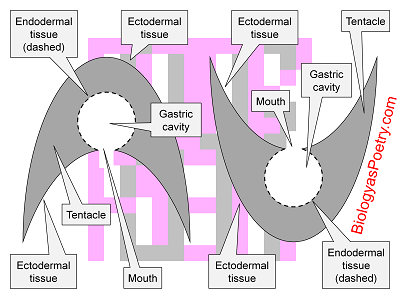∞ generated and posted on 2016.09.02 ∞
Jellyfish, corals, hydra, and sea anemones.
Cnidarians are diploblastic animals, that is, possessing only two distinct tissue types or tissue layers, but nonetheless have a tissue grade of body differentiation. These tissues are found on the outside of their bodies and lining their gastric cavity.
Cnidarians come in two basic forms, what are known as medusas versus what instead are known as polyps. The more general cnidarians life cycle involves an alternation between both stages, medusa as planktonic juveniles (i.e., jellyfish) and polyps as benthic adults (e.g., coral-like or sea anemone-like). Various cnidarians, however, have dispensed with this two-stage life cycle, instead existing solely as medusa, i.e., some jellyfish, or solely as polyps, such as sea anemones.

Figure legend: To the left is a representation of a medusa while to the right is a representation of a polyp. The basic cnidarian life cycle involves passage through both stages with the sexual medusas giving rise to the asexual polyps which in turn produce medusas. More specialized life cycles exist, however, in which either the polyp or medusa stages are absent. In the absence of the medusa stage the polyp instead serves as the sexual stage.
Most cnidarians obtain most of their nutrition by preying upon and then consuming other organisms, whole, including other animals which they subdue using harpoon-like stinging cells known as cnidocytes.